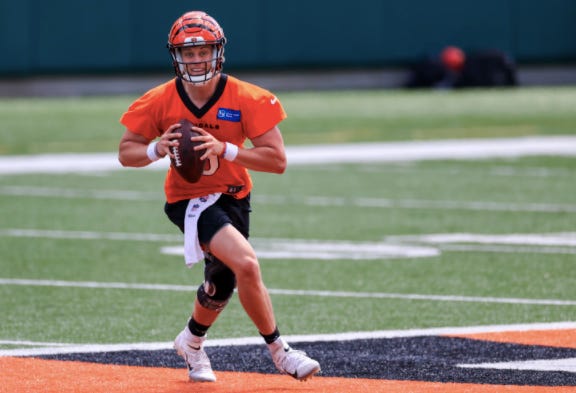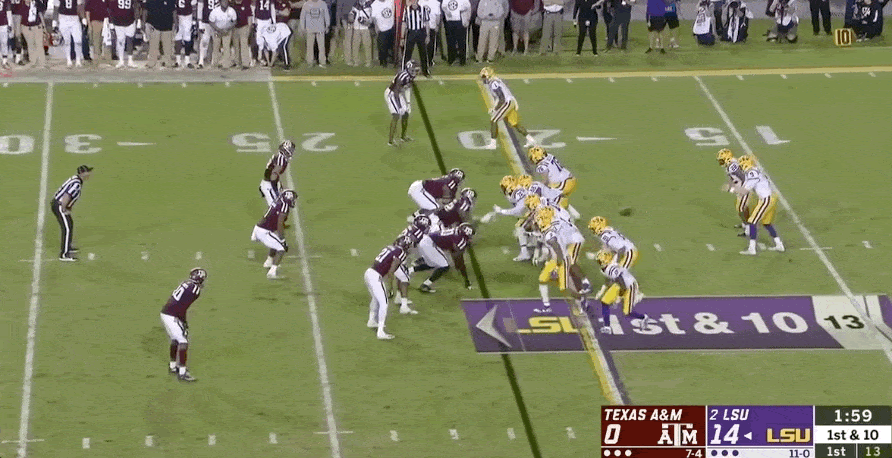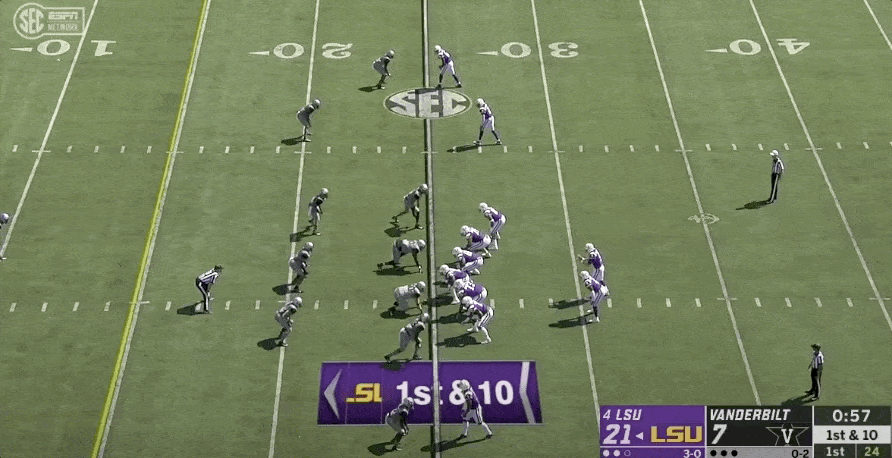What can the Bengals expect from Joe Burrow in 2021?
Plus, Carl Nassib and the encouraging reaction to his coming out.
Joe Burrow was supposed to be last year’s offensive rookie of the year. Instead, a blown-out knee and Justin Herbert’s rise relegated him to an afterthought.
The former Heisman Trophy comes into 2021 with major questions to answer. His rookie campaign was highlighted by prolific performances in losing efforts. He threw for more than 275 yards per game before getting hurt in Week 11, but also needed more than 41 passes each Sunday to get there. He was a top 10 quarterback in terms of average passing yards, but ranked 25th — just behind both Gardner Minshew and Mitchell Trubisky — when it came to yards per attempt.
Was his heroic 2019 — one in which Burrow made Ed Orgeron (DACOACHO!) a national champion — an outlier? Was his lack of efficiency an indicator he was an updated version of Drew Bledsoe? Or was it a sign he’s capable of handling the massive burden of carrying a depleted Bengals roster to new heights and be the man behind the franchise’s first playoff win since … 1990, JESUS CHRIST.
Burrow’s recovery from an imploded knee is going swimmingly. That should clear him to return to the field without issue this fall. What can the Bengals expect?
First things first; Burrow isn’t going to make consistent strides unless the offensive line in front of him gets better.
Burrow ranked fourth last season in sacks taken per game (3.2), 10th in sack rate (7.3 percent), and ninth in total sacks taken (32) despite missing nearly half the season to injury. Factor in the Bengals’ recent lack of success in terms of luring above-average blockers in free agency — recent swings and misses include non-stars like John Miller (lasted one season in Cincy), Bobby Hart (a 57.6 PFF grade in 2019, 66.3 in 2020, now a Buffalo Bill), and Xavier Su’a-Filo (59.1 PFF grade last year) — and all signs point to addressing a porous line in the draft instead.
But no! Oregon bruiser Penei Sewell slid to the Bengals’ pick at No. 5, but the club decided to make Ja’Marr Chase the first wideout off the board. There’s logic to that; Chase is the highest-drafted receiver the team has selected since A.J. Green, who the former LSU standout will be tasked with replacing this fall. That’s a very Cincinnati move; it marked the fifth year in the last six the Bengals selected a pass catcher among the first 55 picks of the draft. Those returns have ranged from solid (Tyler Boyd and Tee Higgins in the second round) to … less so (poor, poor John Ross).
Most of the team’s free agent spending was devoted to rebuilding the league’s 27th-ranked defense, but Cincy found a way to upgrade at right tackle by landing former Viking Riley Reiff (71.4 PFF grade last fall) and drafting second-rounder Jackson Carman, who can kick inside and play guard for the time being. That will help a passing game that was pressured on more than 27 percent of its dropbacks while averaging a bottom-five 2.3 seconds in the pocket per pass.
This is important. I catalogued all 48 touchdown passes Burrow threw against Power 5 opponents (12 games) in the breakthrough 2019 season that made him 2020’s top overall pick. You can watch that here:
Burrow had roughly three seconds in the pocket or more in 34 of those 48 throws. He threw from a clean pocket -- i.e. without having to avoid a pass rusher or taking a hit after throwing -- 36 times. With time to progress through his reads, Burrow’s capable of making magic like turning second-and-goal from the 18 into an easy six points.
This doesn’t mean he’s not capable of standing up to or escaping pressure in order to make throws; he scrambled before hitting a wide open, adjusting wideout plenty of times at LSU. It just means it's a lot easier for him to dial into that five-star talent when he’s got minimal static in front of him.
He didn’t have this luxury as a rookie. Burrow’s average time to throw was 2.65 seconds, per NFL’s Next Gen Stats. That’s on par with colleagues like Nick Mullens, Alex Smith, and Drew Brees -- guys who, in general, threw significantly shorter passes than Burrow’s 8.7 average intended yards per attempt. One great sign is that despite these long throws and consistent pressure, the rookie rarely made backbreaking mistakes. His 1.2 percent interception rate was third-lowest in the NFL. That’s what separates him from an empty stats player to the kind of guy who can lead his team to the postseason.
This is a quarterback who very much wants to stretch defenses vertically, but the line in front of him limited those opportunities.
Fortunately, Burrow has the personnel to match his potential
While the blocking up front is questionable, the Bengals’ receiving corps shouldn’t be. Tyler Boyd suffered a slight downturn last season but remains one of the league’s top slot receivers. He previously thrived as a dangerous WR2 when there’s a true alpha next to him. That’s why Cincinnati made it a priority to draft this guy:
Ja’Marr Chase was drafted in front of Sewell because he can bring the home run instincts vacated when A.J. Green suffered career-altering injuries, then departed for Arizona. Chase sat out the 2020 season, but in 2019 he helped push Burrow to the Heisman with a 1,780-yard, 20 touchdown campaign. He shows up so often on that highlight video above he deserves his own title card. He was so good as a sophomore he made Justin Jefferson LSU’s second-leading wideout.
Burrow’s biggest weakness last season was a lack of touch on his deep ball. Per SIS, he completed just nine of his 45 throws 20+ yards downfield. What better way to remedy that than by acquiring the superstar who averaged 21.2 yards per catch in his final collegiate season?
While Chase lacks Green’s length (6’0 vs. 6’4), he has the speed and route tree to catch up where he left off with his old QB. Flanking him and Boyd will be 2020’s 33rd overall pick (and 6’4 target) Tee Higgins, who was on pace for a 76-catch, 1,118-yard rookie season if you only count the numbers he put up in nine games he played with Burrow in the lineup. Auden Tate will serve as a kinda-perfect WR4.
The tight end group isn’t as stable, but there’s talent there. C.J. Uzomah appeared to have a solid connection with Burrow last fall, albeit in a small sample size. He had eight catches (on 11 targets) for 87 yards and will serve as the vertical option alongside 2019 second rounder Drew Sample. Sample wasn’t able to produce much in the passing game -- his average depth of target was less than half Uzomah’s at 4.2 yards -- but he’s a solid blocker with breakout potential.
This is all great news for the Bengals, because ...
Cincinnati’s gonna throw the hell out of the ball
We saw it last year. We’re probably gonna see it again in 2021. Cincinnati’s defense improved this offseason, but it’s still going to put the Bengals in plenty of come-from-behind situations. The team called passing plays 60.5 percent of the time in 2020 despite losing its starting quarterback with six games to go.
That means fewer opportunities for Joe Mixon and a bottom-tier rushing offense. Honestly, that may be a good thing considering the team’s top two backs averaged 3.5 yards per carry last season. Cincinnati’s blockers struggled to clear space up front, but an upgraded passing offense could create gaps near the line of scrimmage and make things easier for that beleaguered RB corps.
What we might see more of is play action sets. The Bengals utilized the fake at a middling rate -- their 125 play-action snaps (21.5 percent of all pass attempts) ranked 18th in the league last season. That’s something Burrow had used well in Baton Rouge to back off linebackers and temporarily freeze box safeties in order to secure one-on-one matchups down the sideline:
Zac Taylor’s playcalling hasn’t been exactly inspirational -- I’m still fairly convinced he got this job because he knew the city and was standing close enough to Sean McVay in 2019 to get a contact high -- but Burrow’s talent and a deep WR corps around him gives that offense a wide range of options. Cincinnati will be able to stack playmakers at reads 1, 2, 3, and 4 when its second-year quarterback drops back in the pocket. The concern now is whether an underwhelming offensive line can keep him comfortable long enough to figure out which of those four guys is open. -- CD
Carl Nassib made NFL history, and we were ready for it
The NFL had some rare good offseason news to celebrate when Carl Nassib became the league’s first active player to publicly come out as gay.
It’s taken a long time for the NFL to make this particular kind of history, but seven years after Michael Sam became the first openly gay player drafted into the league, it was only a matter of time until it happened. That’s not to diminish Nassib’s decision to break down a barrier — doing so makes it easier for every LGBTQ+ player after him. Even someone who doesn’t play sports can see Nassib, out and proud in the NFL, as a role model.
As Nassib wrote (and was echoed by Roger Goodell), representation matters. “Studies have shown,” Nassib’s post read, “that all it takes is one accepting adult to decrease the risk of an LGBTQ kid attempting suicide by 40%. Whether you’re a friend, a parent, a coach, or a teammate — you can be that person.”
For the most part, Nassib’s coming out was met with support from former and current players, the NFL, the Raiders organization, and fans. (His jersey quickly became a top seller.) If you searched the dregs of social media, you’d probably find some meatheads telling on themselves with a bad-faith negative response — usually of the “why is this news/who cares?” variety, an attempt to both dismiss a major breakthrough and hide their own bigotry. But they were a much smaller minority.
In my opinion, NFL locker rooms have been ready for this moment for a while. Former players have come out before; others, including Warren Moon, have said they’ve known they’ve had gay teammates:

While I don’t doubt there are still players who express homophobic thoughts, we live in a different time than we did even when Chris Culliver was spouting off some anti-gay nonsense eight years ago (which he later apologized for). I think a majority of players these days have had enough exposure to the LGBTQ+ community — in real life, athletes in other sports, and as represented in movies/TV — to willingly accept a teammate of another sexual orientation. Gen Z doesn’t even remember a time when same-sex marriage wasn’t legal in at least one state, and soon enough, anyone coming into the league won’t remember a time when it wasn’t legal in all 50 states.
Nassib’s comments, and the public encouragement he’s received from teammates and coaches, past and present, back that up. “I am also incredibly thankful for the NFL, my coaches, and fellow players for their support,” he wrote. “I would not have been able to do this without them. From the jump, I was greeted with the utmost respect and acceptance.”
When players have talked hypothetically about welcoming a gay teammate, they would usually say all they care about is if you’re a good teammate who can play. Nassib is both, and now we get to see that concept become a reality. This is a big step forward and also something that we’ve been building toward, in the NFL and as a society.
If you’re feeling a little cautious, though, I understand that too. The NFL has said the right things before about how it supports its players, but it doesn’t have the greatest track record of turning those words into action.
And as much collective progress as we’ve made as in terms of LGBTQ+ inclusion, we still live in a time when, just last week, the Supreme Court unanimously sided with a Catholic social service in Philadelphia that refuses to place foster kids with gay couples. Meanwhile, a record number of anti-trans bills have been introduced in state legislatures throughout the country.
Clearly, we have a long way to go, and the fight for equal protection for our LGBTQ+ friends is far from over. But we can still praise Nassib and recognize his announcement for the groundbreaking moment it was. He came out, on his own terms, while in the NFL, and that choice not only made him a trailblazer for everyone who follows in his footsteps, but it also potentially saved lives and opened minds.
Nassib put a face to something that was once a hypothetical — an out gay man playing in the NFL — and showed that the football world and its fans were eager to embrace him and his truth. — SH









